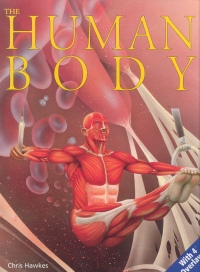| ________________
CM . . .
. Volume XIII Number 2 . . . .September 15, 2006
excerpt:
In a layout similar to that of the “Eyewitness” series, this fantastic book explains the workings of the major systems of the incredible machine known as the human body. Following a page-long introduction, 19 chapters provide detailed information about the featured body systems, not only by means of the text and fact boxes, but also through the use of excellent diagrams and illustrations. The book begins with a general overview of the body systems along with an overlay that shows how they all function together. More specific information follows. Readers will learn about the different types of cells and their unique shapes and purposes. There is an excellent diagram of a cell, but it is much too complicated and gives too much information for the book’s intended audience (this is the only minor flaw in the book). The section covering the skeletal system is rather interesting in that the diagrams show figures in action - golfing, doing cartwheels, walking, and flexing the hands - far more revealing about how the various bones work in tandem than the diagrams found in most books on this subject. Other topics in the book include the skin, hair and nails, different kinds of muscles, the cardiovascular, endocrine, digestive, nervous, excretory, reproductive and immune systems, as well as the senses, genes, aging and disease prevention. One fascinating fact that will amaze readers is that the surface of the entire digestive system is equivalent to the surface area of a tennis court. Despite the complexity of some of the topics, the text is fairly easy to comprehend, providing thorough explanations of the concepts, even in a limited amount of space. Abundant, colour illustrations and diagrams and cross-sections not only give additional information but also add visual appeal. Four overlays are distributed throughout the book. Besides the one previously mentioned, the overlays depict the various parts of the brain, the digestive system, and the development of a fetus, A table of contents and an index are included.
Highly Recommended. Gail Hamilton is a teacher-librarian in Winnipeg, MB.
To comment
on this title or this review, send mail to cm@umanitoba.ca.
Copyright © the Manitoba Library Association. Reproduction for personal
use is permitted only if this copyright notice is maintained. Any
other reproduction is prohibited without permission.
NEXT REVIEW |
TABLE OF CONTENTS FOR THIS ISSUE
- September 15, 2006.
AUTHORS |
TITLES |
MEDIA REVIEWS |
PROFILES |
BACK ISSUES |
SEARCH |
CMARCHIVE |
HOME |
